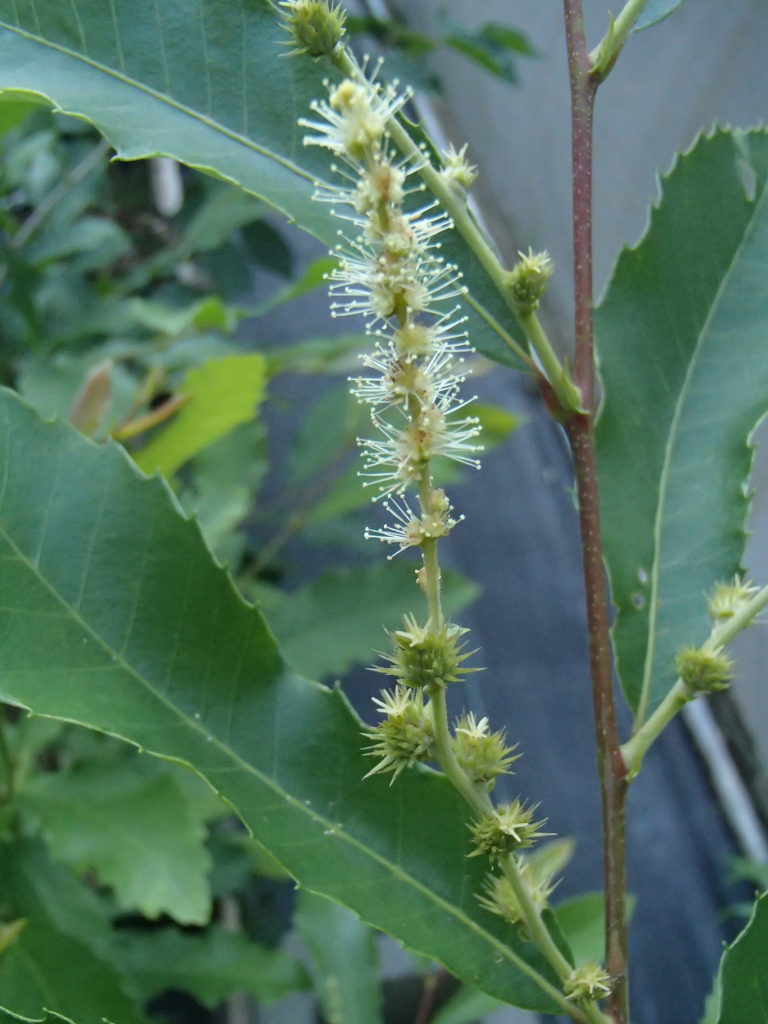Allegheny Chinquapin is a colonial, multi-stemmed shrub or small tree usually around 15 feet tall, taller if grown with single stem or cultivated with little competition. It is native to dry woods and ridges in the Southeastern states, and grows well where summers are hot. It is considered undervalued as a nut tree because its nuts are very sweet and edible, the plants bear nuts early (after only 3-4 seasons) and close to the ground, and they are quite prolific. However, the nuts are sometimes difficult to separate from the burr in which they grow, and also dificult to harvest en masse because they ripen gradually over time, limiting their commercial potential. Consequently, the shrub is valued more as an excellent source of wildlife food and habitat. Small mammals and many bird species feed voraciously on the nuts and the low lateral branches and suckering shoots offer cover for Wild Turkey and Grouse. Closely related to the American Chestnut, it is less susceptible to the Chestnut Blight but not totally resistant. Trees can more often than not recover, but are susceptible to the blight. For this reason it is less often planted by land managers, exacerbating the problem of habitat loss to development. We highly recommend Chinquapin for wildlife, if not for formal landscaping.
NURSERY HOURS
Wednesday: 10-4 Thursday: 10-6 Friday-Saturday: 10-4 Sunday: 12-4
Castanea pumila

Key Info
Scientific Name: Castanea pumila (L.) Mill.
Common Names: Chinquapin (Chinkapin), Allegheny Chinquapin (Chinkapin), Dwarf Chestnut, Bush Chestnut
Family Names: Fagaceae (Beech Family)
Plant Type: Tree / Shrub
Leaf Retention: Deciduous
Flower Color: White
Additional Info
Habit: Multi-stemmed, thicket-forming shrub or small tree with spreading lower branches and ascending upper branches
Height: 15 - 30'
Spread: 6-20'
Soil Conditions: dry, acid, well-drained soils; pH quite acid to neutral, rocky, sandy, sandy loam,
Leaves: Leaves can be quite variable, even on the same plant. They are generally simple, alternate, 3- to 6-inches long, pointy at the tip, pinnately veined, with toothed margins, and are usually glabrous on top and fuzzy on the underside.
Flowers (or reproductive structures: Chinquapin is monoecious and self-incompatible. Flowers can be male, female, or perfect and carry an unpleasant odor. Flowering occurs in spring on wood of the current year's growth. Male flowers are borne in the leaf axils, on catkins 4-6 inches long, yellow to white. Female flowers are rounder, often (but not always) borne on the base of some of the same catkins, 1/8 inch long. The squence of pollen development and transfer is too complex to describe here. When all is said and done, cross pollination is necessary to ensure a good nut crop.
Fruit: The fruit is a brown, lustrous, rounded nut from each spiny green involucre (burr). Nuts mature from late August to September in the South and in September and October farther north.
Natural Distribution: In open stands of dry, deciduous forests or planted pines; on sandy or loamy ridges and hills; railroad rights-of-way, hedgerows, and powerline clearings. It can be locally abundant on longleaf pine and scrub oak habitats that are burned frequently.
USDA Hardiness Zone: 6-10
USDA Wetland Indicator Status in NC: unavailable
Pollination: Wind
Wildlife Connections: Seeds are consumed by fox squirrels, chipmunks, opossums, white-tailed deer, turkeys, blue jays, pileated and red-headed woodpeckers, and many other birds. White-tailed deer also browse the foliage. Dense lower branching provides cover for small mammals and ground-nesting birds (ruffed grouse, northern bobwhite, and wild turkey). Larval host for the Orange-tipped oakworm moth (Illinoiswildflowers.info)
Propagation: Fresh seed germinate in the fall.
